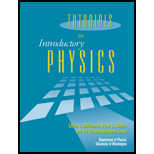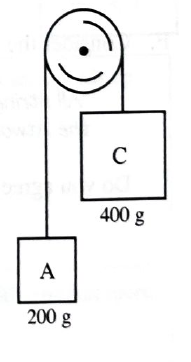
Tutorials in Introductory Physics
1st Edition
ISBN: 9780130970695
Author: Peter S. Shaffer, Lillian C. McDermott
Publisher: Addison Wesley
expand_more
expand_more
format_list_bulleted
Concept explainers
Textbook Question
Chapter 2.3, Problem 3cT
Predict:
• what will happen to object C when it is released.
• how the motion of object C will compare to the motion of object A after they are released.
Explain the basis for your predictions. Do not use algebra.

Expert Solution & Answer
Trending nowThis is a popular solution!

Students have asked these similar questions
Compare the slope of your Data Table 2 graph to the average wavelength (Ave, l) from Data Table 2 by calculating the % Difference. Is the % Difference calculated for the wavelength in Data Table 2 within an acceptable % error? Explain why or why not?
The slope of a graph of velocity, v, vs frequency, f, is equal to wavelength, l. Compare the slope of your Data Table 1 graph to the average wavelength (Ave, l) from Data Table 1 by calculating the % Difference.
Examine the slope of the line on the graph created using the data in Data Table 4 of Period, T2 vs L, the slope of the line is a constant containing the acceleration due to gravity, g. Using the slope of your line, determine the experimental value for g. Compare the value you determined for g from the slope of the graph to the expected value of 9.81 m/s2 by calculating the percent error.
Chapter 2 Solutions
Tutorials in Introductory Physics
Ch. 2.1 - Draw a large dot on your large sheet of paper to...Ch. 2.1 - Describe the remaining forces you have indicated...Ch. 2.1 - All forces arise from interactions between...Ch. 2.1 - There are many different types of forces,...Ch. 2.1 - Consider the following discussion between two...Ch. 2.1 - Label each of the forces on your free-body diagram...Ch. 2.1 - Sketch a free-body diagram for a book at rest on a...Ch. 2.1 - A second book of greater mass is placed on top of...Ch. 2.1 - Compare the free-body diagram for the lower book...Ch. 2.1 - Which, if any, Newton’s third law force pairs are...
Ch. 2.1 - A magnet is supported by another magnet as shown...Ch. 2.1 - An iron rod is held up by a magnet as shown. The...Ch. 2.2 - Compare the net force (magnitude and direction) on...Ch. 2.2 - Draw separate free-body diagrams for system A and...Ch. 2.2 - Is the magnitude of the force exerted on system A...Ch. 2.2 - D. Identify all the Newton's third law...Ch. 2.2 - Rank the magnitudes of the horizontal forces that...Ch. 2.2 - Suppose the mass of each brick is 2.5 kg, the...Ch. 2.2 - Describe the motions of systems A and B. How does...Ch. 2.2 - Compare the net force (magnitude and direction) on...Ch. 2.2 - Draw and label separate free-body diagrams for...Ch. 2.2 - Consider the following discussion between two...Ch. 2.2 - Rank the magnitudes of all the horizontal forces...Ch. 2.2 - Compare the magnitude of the netforce on system C...Ch. 2.2 - Draw and label a free-body diagram for system C....Ch. 2.2 - At right is a free-body diagram for a cart. All...Ch. 2.3 - Describe the motions of block A, block B, and the...Ch. 2.3 - On a large sheet of paper, draw a separate...Ch. 2.3 - Identify all the Newton's third law...Ch. 2.3 - Rank, from largest to smallest, the magnitudes of...Ch. 2.3 - Consider the horizontal components of the forces...Ch. 2.3 - If the motion of the blocks is the same as in...Ch. 2.3 - Suppose the mass of the string that connects...Ch. 2.3 - A string exerts a force on each of the two objects...Ch. 2.3 - If you know that the net force on a massless...Ch. 2.3 - Predict the subsequent motions of objects A and B...Ch. 2.3 - Draw separate free-body diagrams for objects A and...Ch. 2.3 - Predict: • what will happen to object C when it is...Ch. 2.3 - Draw and label separate free-body diagrams for...Ch. 2.3 - The weight of a 200 g mass has magnitude...Ch. 2.3 - Consider the following statement about the...
Additional Science Textbook Solutions
Find more solutions based on key concepts
28. Consider the reaction
Express the rate of the reaction in terms of the change in concentration of e...
Chemistry: Structure and Properties (2nd Edition)
What name is given to the zone of greatest seismic activity?
Applications and Investigations in Earth Science (9th Edition)
Describe the 1H NMR spectrum you would expect for each of the following compounds, indicating the relative posi...
Organic Chemistry (8th Edition)
APPLY 1.2 Express the following quantities in scientific notation
using fundamental SI units of mass and lengt...
Chemistry (7th Edition)
Which of the following factors would tend to increase membrane fluidity? A. a greater proportion of unsaturated...
Campbell Biology in Focus (2nd Edition)
Two culture media were inoculated with four different bacteria. After incubation, the following results were ob...
Microbiology: An Introduction
Knowledge Booster
Learn more about
Need a deep-dive on the concept behind this application? Look no further. Learn more about this topic, physics and related others by exploring similar questions and additional content below.Similar questions
- From your examination of the graph created using the data in Data Table 4 of Period, T vs √L . What would you determine is the relationship between the period of a pendulum and the length of a pendulum?arrow_forwardIn a certain bimetallic strip, the brass strip is 0.100% longer than the steel strip at a temperature of 283°C. At what temperature do the two strips have the same length? Coefficients of linear expansion for steel α = 12.0 × 10−6 K−1 and for brass α = 19.0 × 10−6 K−1 (see Table 13.2).arrow_forwardReview Conceptual Example 2 before attempting this problem. Two slits are 0.158 mm apart. A mixture of red light (wavelength = 693 nm) and yellow-green light (wavelength = 567 nm) falls on the slits. A flat observation screen is located 2.42 m away. What is the distance on the screen between the third-order red fringe and the third-order yellow-green fringe? m = 3 m = 3 m = 0 m = 3 m = 3 Fringes on observation screenarrow_forward
- A film of oil lies on wet pavement. The refractive index of the oil exceeds that of the water. The film has the minimum nonzero thickness such that it appears dark due to destructive interference when viewed in visible light with wavelength 643 nm in vacuum. Assuming that the visible spectrum extends from 380 to 750 nm, what is the longest visible wavelength (in vacuum) for which the film will appear bright due to constructive interference? Number Unitsarrow_forwardA piece of metal is placed on top of a 2.0 - kg wooden block (mass density = 562 kg/m³) piece. UseArchimedes' principle to calculate the mass (in kg) of copper if the top of the wood surface is exactly at thewater's surface?arrow_forwardA filmmaker wants to achieve an interesting visual effect by filming a scene through a converging lens with a focal length of 50.0 m. The lens is placed betwen the camera and a horse, which canters toward the camera at a constant speed of 7.9 m/s. The camera starts rolling when the horse is 36.0 m from the lens. Find the average speed of the image of the horse (a) during the first 2.0 s after the camera starts rolling and (b) during the following 2.0 s.arrow_forward
- What is the direction of the magnetic force on a NEGATIVE CHARGE that moves as shown in each of the six cases?arrow_forwardHi! I need help with these calculations for part i and part k for a physics Diffraction Lab. We used a slit width 0.4 mm to measure our pattern.arrow_forwardExamine the data and % error values in Data Table 3 where the angular displacement of the simple pendulum decreased but the mass of the pendulum bob and the length of the pendulum remained constant. Describe whether or not your data shows that the period of the pendulum depends on the angular displacement of the pendulum bob, to within a reasonable percent error.arrow_forward
arrow_back_ios
SEE MORE QUESTIONS
arrow_forward_ios
Recommended textbooks for you
 College PhysicsPhysicsISBN:9781285737027Author:Raymond A. Serway, Chris VuillePublisher:Cengage Learning
College PhysicsPhysicsISBN:9781285737027Author:Raymond A. Serway, Chris VuillePublisher:Cengage Learning Physics for Scientists and EngineersPhysicsISBN:9781337553278Author:Raymond A. Serway, John W. JewettPublisher:Cengage Learning
Physics for Scientists and EngineersPhysicsISBN:9781337553278Author:Raymond A. Serway, John W. JewettPublisher:Cengage Learning Physics for Scientists and Engineers with Modern ...PhysicsISBN:9781337553292Author:Raymond A. Serway, John W. JewettPublisher:Cengage Learning
Physics for Scientists and Engineers with Modern ...PhysicsISBN:9781337553292Author:Raymond A. Serway, John W. JewettPublisher:Cengage Learning Glencoe Physics: Principles and Problems, Student...PhysicsISBN:9780078807213Author:Paul W. ZitzewitzPublisher:Glencoe/McGraw-Hill
Glencoe Physics: Principles and Problems, Student...PhysicsISBN:9780078807213Author:Paul W. ZitzewitzPublisher:Glencoe/McGraw-Hill University Physics Volume 1PhysicsISBN:9781938168277Author:William Moebs, Samuel J. Ling, Jeff SannyPublisher:OpenStax - Rice University
University Physics Volume 1PhysicsISBN:9781938168277Author:William Moebs, Samuel J. Ling, Jeff SannyPublisher:OpenStax - Rice University Classical Dynamics of Particles and SystemsPhysicsISBN:9780534408961Author:Stephen T. Thornton, Jerry B. MarionPublisher:Cengage Learning
Classical Dynamics of Particles and SystemsPhysicsISBN:9780534408961Author:Stephen T. Thornton, Jerry B. MarionPublisher:Cengage Learning

College Physics
Physics
ISBN:9781285737027
Author:Raymond A. Serway, Chris Vuille
Publisher:Cengage Learning

Physics for Scientists and Engineers
Physics
ISBN:9781337553278
Author:Raymond A. Serway, John W. Jewett
Publisher:Cengage Learning

Physics for Scientists and Engineers with Modern ...
Physics
ISBN:9781337553292
Author:Raymond A. Serway, John W. Jewett
Publisher:Cengage Learning

Glencoe Physics: Principles and Problems, Student...
Physics
ISBN:9780078807213
Author:Paul W. Zitzewitz
Publisher:Glencoe/McGraw-Hill

University Physics Volume 1
Physics
ISBN:9781938168277
Author:William Moebs, Samuel J. Ling, Jeff Sanny
Publisher:OpenStax - Rice University

Classical Dynamics of Particles and Systems
Physics
ISBN:9780534408961
Author:Stephen T. Thornton, Jerry B. Marion
Publisher:Cengage Learning
Position/Velocity/Acceleration Part 1: Definitions; Author: Professor Dave explains;https://www.youtube.com/watch?v=4dCrkp8qgLU;License: Standard YouTube License, CC-BY